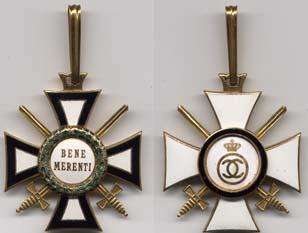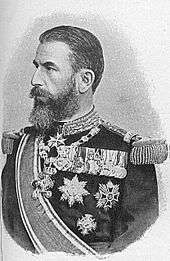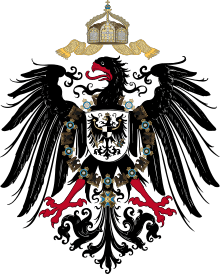House Order of Hohenzollern
| Imperial and Royal Prussian House Order of Hohenzollern Kaiserlich und Königlich PreuBen Haus Orden von Hohenzollern Princely House Order of Hohenzollern Fürstlich Haus Orden von Hohenzollern | |
|---|---|
 | |
| Collar of the Order | |
| Awarded by | |
| Type | State Order (formerly) House Order (currently) |
| Royal house | House of Prussia House of Hohenzollern |
| Ribbon | White with a Black stripe in the middle and either side |
| Status | Currently Constituted |
| Sovereigns | Georg Friedrich, Prince of Prussia Karl Friedrich, Prince of Hohenzollern |
| Grades (w/ post-nominals) | Knight Grand Cordon/Cross with Collar Knight Grand Cordon/Cross with Chain Knight/Dame Grand Cordon, Special Class Knight/Dame Grand Cordon Knight/Dame Grand Officer Knight/Dame Grand Commander Knight/Dame Commander Knight/Dame Officer Knight/Dame Member Medal |
| Established | 5 December 1841 |
| Precedence | |
| Next (higher) | House of Prussia: Imperial and Royal Order of Merit of the Prussian Crown House of Hohenzollern: None (highest) |
| Next (lower) | House of Prussia: Imperial and Royal Order of Merit House of Hohenzollern: Hohenzollern Decoration of Merit |
| Same | House of Prussia: Imperial and Royal German Order of Saint John House of Hohenzollern: None |
| Related | Romanian House Order of Hohenzollern |
| | |
| The Ribbon of the Order | |
The House Order of Hohenzollern (Hausorden von Hohenzollern or Hohenzollernscher Hausorden) was a dynastic order of knighthood of the House of Hohenzollern awarded to military commissioned officers and civilians of comparable status. Associated with the various versions of the order were crosses and medals which could be awarded to lower-ranking soldiers and civilians.
History
The House Order of Hohenzollern was instituted on December 5, 1841 by joint decree of Prince Konstantin of Hohenzollern-Hechingen and Prince Karl Anton of Hohenzollern-Sigmaringen. These two principalities in southern Germany were Catholic collateral lines of the House of Hohenzollern, cousins to the Protestant ruling house of Prussia.
On August 23, 1851, after the two principalities had been annexed by Prussia, the order was adopted by the Prussian branch of the house. Also, although the two principalities had become an administrative region of the Prussian kingdom, the princely lines continued to award the order as a house order. The Prussian version was then known as the Royal House Order of Hohenzollern (Königlicher Hausorden von Hohenzollern or Königlich Hohenzollernscher Hausorden), to distinguish it from the Princely House Order of Hohenzollern (Fürstlicher Hausorden von Hohenzollern or Fürstlich Hohenzollernscher Hausorden). Although Kaiser Wilhelm II abdicated in 1918 as German Emperor and King of Prussia, he did not relinquish his role as Head of the Royal House and as such he was still able to confer the Royal House Order. The Princely House Order continued to be awarded, unofficially, after the fall of the German Monarchy.
Another development occurred in 1935. Prince Karl Anton's second son, Karl Eitel Friedrich of Hohenzollern-Sigmaringen, had become prince and then king of Romania as Carol I. Carol I had died childless and was succeeded by his nephew Ferdinand I, also of Hohenzollern-Sigmaringen. During the reign of Ferdinand's son King Carol II, the Romanian government established its own version of the House Order of Hohenzollern, known in Romanian as Ordinul "Bene Merenti" al Casei Domnitoare ("Order of 'Bene Merenti' of the Ruling House"). This form of the order existed until the Romanian monarchy was abolished in 1947; King Michael also awarded a slightly altered order in exile.
Classes
Royal House Order
The Royal House Order of Hohenzollern came in the following classes:
- Grand Commander (Großkomtur)
- Commander (Komtur)
- Knight (Ritter)
- Member (Inhaber)
"Member" was a lesser class for soldiers who were not officers, and civilians. The Members' Cross (Kreuz der Inhaber), especially with swords, was a rare distinction for non-commissioned officers and the like. Another decoration, the Members' Eagle (Adler der Inhaber) was often given as a long-service award to lesser officials such as schoolteachers. The "Eagles" (the Members' Eagle and the Knights' Eagle, or Adler der Ritter) were solely civilian awards, and could not be awarded with swords. All other grades could be awarded with swords. During World War I, the Knight's Cross with Swords of the Royal House Order of Hohenzollern became in effect an intermediate award between the Iron Cross 1st Class and the Pour le Mérite for Prussian junior officers. When awarded with swords it was worn on the ribbon of the Iron Cross.
Princely House Order
The Princely House Order of Hohenzollern came in the following classes:
- Honor Cross 1st Class (Ehrenkreuz 1. Klasse)
- Honor Commander's Cross (Ehrenkomturkreuz)
- Honor Cross 2nd Class (Ehrenkreuz 2. Klasse)
- Honor Cross 3rd Class (Ehrenkreuz 3. Klasse)
- Golden Merit Cross (goldenes Verdienstkreuz)
- Silver Merit Cross (silbernes Verdienstkreuz)
- Golden Honor Medal (goldene Ehrenmedaille)
- Silver Merit Medal (silberne Verdienstmedaille)
The Merit Crosses, Golden Honor Medal and Silver Merit Medal were lesser grades for non-commissioned officers, enlisted men and their civilian equivalents. All grades could be awarded with swords. During World War I, the appropriate grade of the Princely House Order was often awarded to officers and men of Füsilier-Regiment Fürst Karl Anton von Hohenzollern (Hohenzollernsches) Nr. 40, an infantry regiment raised in the principalities of Hohenzollern and whose honorary chief was the Prince of Hohenzollern. Soldier in the regiment's sister reserve and Landwehr regiments also often received the decoration. Unlike the Royal House Order, awards of the Princely House Order were made on the standard ribbon of the order (the "statute" ribbon) regardless of whether they were with or without swords.
Romanian House Order
The classes of the Romanian version of the House Order were essentially the same as those of the Princely House Order, except that the Honor Cross 3rd Class of the Romanian version could be awarded with Oakleaves, and the Golden and Silver Medals could be awarded with a Crown. As with the Prussian and Hohenzollern versions, crossed swords could be used to indicate a wartime or combat award. Given the short existence of the order and the fact that Romania had a number of other decorations for valor and military merit (Order of Michael the Brave, Order of the Star of Romania, Order of the Crown of Romania, Air Force Bravery Order, Cross of Military Virtue, Air Force and Naval Bravery Crosses, Crosses and Medals for Faithful Service, Medals for Steadfastness and Loyalty), awards of the Romanian version of the House Order with swords are uncommon.
Insignia
The badge of the House Order of Hohenzollern was a cross pattée with convex edges and curved arms (sometimes called an "Alisee" cross). There were differences in the enameling of the arms of the cross for the Royal, Princely and Romanian versions, but all featured white enamel on the higher classes and a black enameled stripe near the sides of the cross. Between the arms of the cross was a wreath of laurel leaves (left side) and oak leaves (right side).
The cross bore a center medallion; the medallion and its band bore different coats of arms, mottos, dates and ciphers for each of the Royal, Princely and Romanian versions:
- The white-enameled medallion of the Royal House Order of Hohenzollern bore a black Prussian royal eagle with the Hohenzollern house coat of arms on a shield on the eagle's chest. Around the center medallion, a gold-rimmed band of blue enamel bore the motto in gold letters: "VOM FELS ZUM MEER" ("From the cliffs to the sea"), with a wreath of laurel below. The white-enameled medallion on the reverse bore the cipher of King Frederick William IV of Prussia, the king when the order was founded. A gold-rimmed band of blue enamel bore the date "DEN 18. JANUAR 1851" with a wreath of laurel leaves (left side) and oak leaves (right side).
- The white-enameled medallion of the Princely House Order of Hohenzollern bore the Hohenzollern coat of arms (a quartered shield of black and white) under a princely crown. Around the center medallion, a gold-rimmed band of blue enamel bore the motto in gold letters: "FÜR TREUE UND VERDIENST" ("For loyalty and merit") with a smaller wreath of oakleaves below. On most grades, the white-enameled medallion on the reverse bore the intertwined ciphers ("F" and "A") of Princes Friedrich (Konstantin's actual first name) and Anton, the princes who founded the order, under a princely crown. The gold-rimmed band of blue enamel bore one of several dates, depending on the class, such as "DEN 5T APRIL 1844" for the 2nd and 3rd Classes, with a wreath of laurel leaves below.

- The white-enameled medallion of the Romanian House Order bore a black Romanian eagle with the Hohenzollern coat of arms on a shield on the eagle's chest. Around the center medallion, a gold-rimmed band of blue enamel bore the motto in gold letters: "NIHIL SINE DEO" ("Nothing without God"). The white-enameled medallion on the reverse bore the crowned cipher of King Carol. The gold-rimmed band of blue enamel bore the date of the founding of the Romanian kingdom, "10 FEBRUARIE 1881".
The statute ribbon of the order was white with three black stripes (with slight variations among the Royal, Princely and Romanian versions).
Notable recipients

The following list is only a sample of some of the more prominent recipients' names. As noted above, the Knight's Cross with Swords of the Royal House Order was the intermediate decoration between the Iron Cross 1st Class and the Pour le Mérite for Prussian junior officers. There were over 8,000 awards during World War I of this class (there were far fewer awards of the other classes, or of any class before the war). Thus, among the ranks of Imperial German Army junior officers who earned the Royal House Order as lieutenants, captains or majors in World War I are several hundred who reached the rank of general the Wehrmacht in World War II.
- Hermann Balck - Later a General der Panzertruppe and one of the most highly decorated officers in the Wehrmacht
- Ludwig Beck - Later a Colonel General in the Wehrmacht, Chief of the OKH and leader of the conspiracy against Hitler
- Werner von Blomberg - Later a Field Marshal in the Wehrmacht and War Minister of Germany; also received the Pour le Mérite
- Leonhard Graf von Blumenthal – Prussian Field Marshal of the Wars of Unification; held the Royal House Order Grand Commander with Swords on Ring and Commander with Star with Swords; also received the Pour le Mérite with Oakleaves and Diamonds.
- Günther Blumentritt – Later a General der Infanterie in the Wehrmacht
- Fedor von Bock - Later a Field Marshal in the Wehrmacht; also received the Pour le Mérite
- Oswald Boelcke - One of Germany's top aces of World War I; also received the Pour le Mérite.
- Friedrich Bogendörfer – Also received the Pour le Mérite; later knighted and ennobled with Bavaria's Military Order of Max Joseph, becoming Friedrich Ritter von Bogendörfer
- Walter von Brauchitsch - Later a Field Marshal in the Wehrmacht and commander of the German Army
- Ernst Busch - Later a Field Marshal in the Wehrmacht; also received the Pour le Mérite
- Jakob Danner – Bavarian officer later knighted and ennobled with Bavaria's Military Order of Max Joseph, becoming Jakob Ritter von Danner; In 1923 he was instrumental in putting down the Beer Hall Putsch
- Friedrich-Wilhelm Dernen - Baden junior officer; also received the Pour le Mérite and Baden's Military Karl-Friedrich Merit Order
- Karl Dönitz - Later a Grand Admiral in the Kriegsmarine and briefly successor to Hitler as leader of Germany.
- Franz Ritter von Epp – Bavarian combat commander; also received the Pour le Mérite, Bavaria's Military Order of Max Joseph; later Reichsstatthalter of Bavaria (1933–45)
- Alexander von Falkenhausen - Later a General der Infanterie in the Wehrmacht and military governor of occupied Belgium; also received the Pour le Mérite
- Victor Franke – Schutztruppe officer and highly decorated veteran of Germany's colonial campaigns in Africa; also received the Pour le Mérite
- Werner Freiherr von Fritsch - Later a Colonel General in the Wehrmacht and commander of the German Army
- Werner Albrecht Freiherr von und zu Gilsa was a German officer and General of Infantry, whose last assignment was as Wehrmacht commandant of Dresden. In 1936, while a lieutenant colonel, Gilsa became commandant of the Olympic Village, during the Berlin Olympic Games, summer 1936, after the demotion of Wolfgang Fürstner.
- Hermann Göring - Later Reichsmarschall; also received the Pour le Mérite, Baden's Military Karl-Friedrich Merit Order, numerous other decorations
- Robert Ritter von Greim - Later a Field Marshal in the Luftwaffe; also received the Pour le Mérite and Bavaria's Military Order of Max Joseph
- Franz Halder - Later a Colonel General in the Wehrmacht and Chief of the OKH
- Paul Hausser – Later an Oberstgruppenführer in the Waffen SS
- Gotthard Heinrici - Later a Colonel General in the Wehrmacht
- Erich Hoepner - Later a Colonel General in the Wehrmacht and leader of the conspiracy against Hitler
- Hans-Valentin Hube - Later a Colonel General and one of the most highly decorated officers in the Wehrmacht
- Max Immelmann - German World War I ace whose early exploits and fame led to the nickname for the Pour le Mérite as the "Blue Max"; also received the Knight's Cross and Commander's Cross of Saxony's Military Order of St. Henry
- Ernst Jünger - Later awarded the Pour le Mérite. Author of a famous memoir of World War I, Storm of Steel. During World War II, he rejoined the Wehrmacht as a captain and served in the occupation forces in Paris.
- Wilhelm Keitel - Later a Field Marshal in the Wehrmacht and Chief of the OKW
- Günther von Kluge - Later a Field Marshal in the Wehrmacht
- Hermann Köhl – World War I aviator and aviation pioneer; made first successful East-West trans-Atlantic crossing; also received the Pour le Mérite, Württemberg's Military Merit Order, U.S. Distinguished Flying Cross
- Georg von Küchler - Later a Field Marshal in the Wehrmacht
- Wilhelm Ritter von Leeb - Later a Field Marshal in the Wehrmacht; also received Bavaria's Military Order of Max Joseph
- Wilhelm List - Later a Field Marshal in the Wehrmacht
- Bruno Loerzer - Later a Colonel General in the Luftwaffe; also received the Pour le Mérite
- Erich Löwenhardt - Third highest scoring German ace of World War I; also received the Pour le Mérite
- Erich von Manstein - Later a Field Marshal in the Wehrmacht
- Walter Model - Later a Field Marshal and one of the most highly decorated officers in the Wehrmacht
- Helmuth von Moltke the Elder – Prussian Field Marshal of the Wars of Unification; held the Royal House Order Grand Commander with Swords; also held the Pour le Mérite with Oakleaves, Crown and Diamonds, the Grand Cross of the Pour le Mérite and the Civil Class of the Pour le Mérite, among many other honors
- Louis Alfred Carl Oscar Müldner von Mülnheim, Major and aide-de-camp to the German Crown prince
- Karl August Nerger, German auxiliary cruiser commander; one of only two junior officers to receive the highest military honors of the five main German states: the Pour le Mérite, Bavaria's Military Order of Max Joseph, Saxony's Military Order of St. Henry, Württemberg's Military Merit Order and Baden's Military Karl-Friedrich Merit Order
- Theo Osterkamp – World War I fighter ace and Pour le Mérite recipient; also flew in World War II and rose to Generalleutnant
- Erich Raeder - Later a Grand Admiral in the Kriegsmarine
- Walter von Reichenau - Later a Field Marshal in the Wehrmacht
- Manfred Freiherr von Richthofen – Top German ace of World War I; also received the Pour le Mérite, Saxony's Military Order of St. Henry, Württemberg's Military Merit Order and numerous other decorations
- Gerd von Rundstedt - Later a Field Marshal in the Wehrmacht
- Dietrich von Saucken - Later a General der Panzertruppe and one of the most highly decorated officers in the Wehrmacht
- Friedrich Graf von der Schulenburg – Received the Knight's Cross of the Royal House Order as a Lt. Colonel and the Commander's Cross as Colonel; also received the Pour le Mérite with Oakleaves and the Order of the Red Eagle 2nd Class with Swords, Oakleaves and Crown
- Hugo Sperrle - Later a Field Marshal in the Luftwaffe; also received Württemberg's Military Merit Order
- Kurt Student - Later a Colonel General and commander of German airborne troops
- Ernst Udet – Second highest scoring German ace of World War I; also received the Pour le Mérite; later a Colonel General in the Luftwaffe
- Alfred von Waldersee – Prussian Field Marshal and Chief of the German General Staff; held the Royal House Order Grand Commander with Swords on Ring and the Knight with Swords
- Erwin von Witzleben - Later a Field Marshal in the Wehrmacht and leader of the conspiracy against Hitler
.png)
